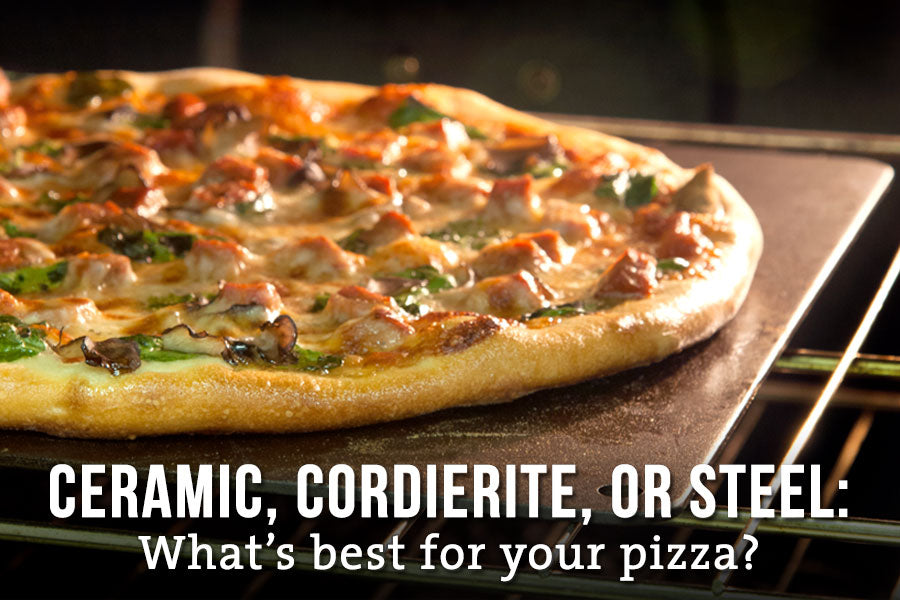Ceramic vs. Cordierite Stones vs. Baking Steels
Your home oven can bake, braise, broil, and roast just about anything you pick out for dinner, but there’s one dish it needs a little help with: pizza. Home ovens simply don’t get hot enough to make the perfect pizza, unless you have the help of a good baking surface capable of retaining high heat in order to get the job done. So which baking platform is best, and which one is right for you? It depends really, so let’s take a look at the different types of pizza stones available help you make your homemade pizza the absolute best.
Ceramic Pizza Stones
A pizza stone is a pizza stone, right? Wrong! Not only do pizza stones come in different shapes and sizes, they’re also made from different materials. Ceramic pizza stones are perhaps the most cost-effective answer when shopping for a stone. Made from clay and fired in a kiln, these stones are great at conducting high heat evenly, which makes them great at baking pizza. When properly cared for, ceramic stones can last for many years.
Cordierite Stones
Slightly more expensive and extremely durable, cordierite stones are built to outlast all others. Cordierite is a mineral known for its ability to handle extreme temperatures well. It’s the same material they use to make kiln shelves, and it’s thermal shock resistant. This means you can take a cordierite stone from a low temperature to a very high temperature without the risk of breaking it. These stones can literally handle all the heat your oven or grill can dish out and still keep cranking out pizzas year after year.

The Baking Steel
The most recent addition to the home baker’s arsenal is the pizza / baking steel. The terms are interchangeable since it can master pizzas, breads, pastries, and more. While they radiate heat less evenly than ceramic or cordierite stones, pizza steels are capable of achieving higher temperatures than their stone competitors. Using a special technique involving your oven’s broiler, you can bake pizzas that rival your local artisan establishment. Steels can also be used in combination with pizza stones for those of you who don’t have a top-mounted broiler in your oven. The best part is that baking steels are nearly indestructible. Not only will they stand up to any amount of heat you subject them to, but they’ll also easily survive being dropped on the ground. Baking steels require a little more maintenance that stones, as you’ll need to season them from time to time to prevent rust. If you’d like a good picture of how pizza steels work, check out our previous post on baking steels.
The Right Tool for You
Ultimately the best baking surface should cater to your specific needs. Having said that, if you’re on a budget and take a more laid-back approach to pizza, ceramics will be your best bet. If you’re strictly business when making pies at home a durable, next-level cordierite stone is the baking surface for you. If you’re a home pizza professional and you’ll only settle for the best, then the baking steel is your only logical choice. Whatever baking surface you choose, you’ll have crispier, faster, and more delicious pizza. Even better, if you take good care of your stone or steel you’ll have better pizza and breads for years and years to come.
Check out some of our other pizza tips:
- Help, My Pizza Is Stuck To My Pizza Peel
- No Mixer? No Problem. No-Knead Pizza Dough Recipe
- Store-Bought Dough: Who's Is Best
- All About Yeast
See what we cooking today in the Pizzacraft kitchen - Instagram: @_Pizzacraft




7 comments
David korver, I’ve been thinking about using a steel to replace my broken stone in my pizzaque kettle set up. But I’m worried about it burning the bottoms! Anybody else tried this?
I don’t know why pizza screens are rated to 450F. I’ve used one at stone temps up to 800F and have not had a problem. Aluminum melts at over 1300F, so not even close. I can’t see a problem.
Hi Corry,
There is no additional aluminum in that stone beyond what is natural to cordierite.
Does the Cordierite Stone used by PizzaCraft contain aluminum?